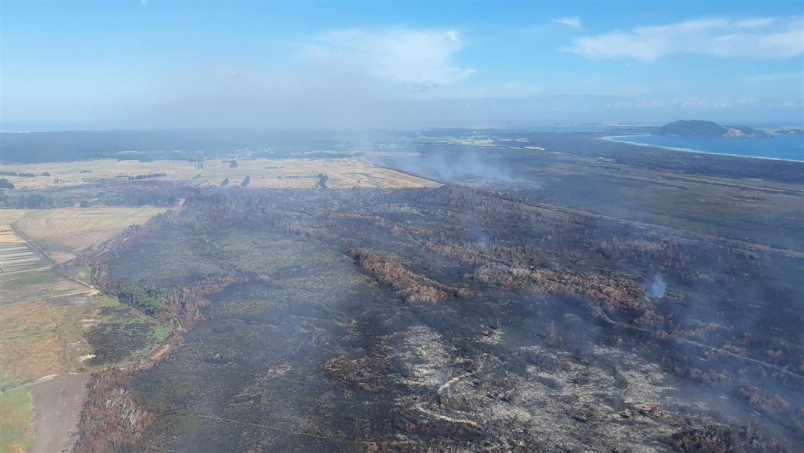More than 600,000 tonnes of carbon worth an estimated $32m were lost in fires at two of New Zealand’s most important wetlands. By Caroline Wood
Forest & Bird magazine
A version of this story was first published in the Autumn 2025 issue of Forest & Bird magazine.
Extensive peatland fires took hold in the northern and southernmost parts of the country in 2022. In Kaimaumau-Motutangi, Northland, the burnt area was over 2900ha, while at Awarua, Southland, it was 980ha.
These wetlands are “peatlands”, which have an incredible ability to store carbon in the peat that has built up over tens of thousands of years.
Natural peatland fires occurred in New Zealand before human arrival, but the recent increased frequency is due to human activities and is concerning, say experts.
DOC freshwater scientist Hugh Robertson says calculating carbon loss really brings home the impact of wetland fires on New Zealand’s stores of carbon.
“Carbon emissions from the 2022 fires were large, estimated at more than 515,000 tonnes of carbon dioxide emissions from Kaimaumau and more than 104,000 tonnes from Awarua. All of that carbon was released into the atmosphere,” he said.
Hugh says peat soils are highly flammable, particularly when they are dried out.
“If we reduce drainage and protect our wetlands, we’re supporting an important nature-based solution to climate change. Re-wetting our wetlands will make them less likely to burn and will reduce greenhouse gas emissions.”
Manaaki Whenua Landcare Research scientist Jack Pronger says the loss of carbon due to the two fires represents about 5% of New Zealand’s annual target for the 2026–2030 emissions reduction period.
“Year-on-year vegetation growth in peatlands removes carbon dioxide from the atmosphere and stores it as peat soil,” he explains.
“Fire stops this process by releasing carbon back into the air, which then contributes to greenhouse gas emissions.”

The peatland fire in the Kaimaumau wetland (Jan 2022). Image: DOC
If the carbon losses for the two fires had to be paid for, the estimated cost would be about $32 million based on current carbon markets, according to a landmark report published last October.
The report on carbon emissions from the 2022 fires was a collaboration involving DOC and Manaaki Whenua scientists and supported by local iwi, in particular Ngāi Takoto and Awarua Runaka.
It was the first detailed study on peatland fire carbon emissions completed in New Zealand.
The report notes that carbon loss from the fires was probably higher than calculated.
The fires also caused a loss of over 3000ha of native vegetation and damaged habitats of the critically threatened matuku-hūrepo Australasian bittern and at-risk freshwater fish.
“Recovery and restoration of the Kaimaumau and Awarua wetlands will require extensive weed control, as the bare burnt ground allows exotic plants to establish,” Hugh says.
Wetlands aren’t currently included in New Zealand’s emissions trading scheme or carbon accounting.
The research highlights the significant potential of wetlands to contribute to our response to climate change. This potential is also noted in New Zealand’s Emissions Reduction Plan.
You can download the report Estimating carbon emissions from peatland fires at Kaimaumau – Motutangi and Awarua wetlands here.
Every wetland counts

Whangamarino wetland before the 2024 fire. Image: Markus Stirnemann
Healthy wetlands help protect communities from flooding, act as carbon sinks, and provide safe homes for more native species.
Protecting and rewetting wetlands is a nature-based climate solution that’s been proven to work.
It’s vital we don’t lose any more as 90% of our historic wetlands have been drained to make way for homes, farming, and other land uses.
Forest & Bird’s freshwater advocate Tom Kay is asking nature lovers to support wetlands this year by making a submission in a vitally important public consultation on freshwater policy reform.
At the time of writing, the National-led coalition was preparing a discussion document on the future of the National Policy Statement for Freshwater Management and associated national environmental standards.
The government wants to weaken existing freshwater protections, including potentially making it easier for private commercial interests to destroy wetlands.

